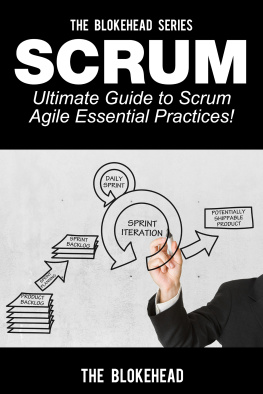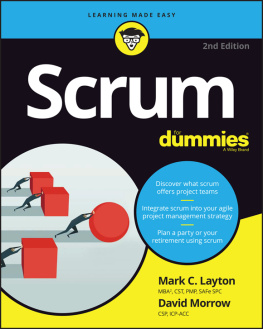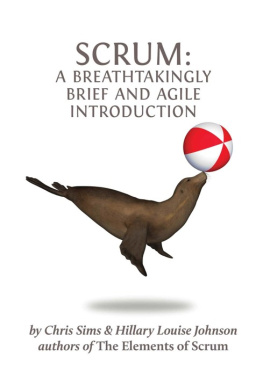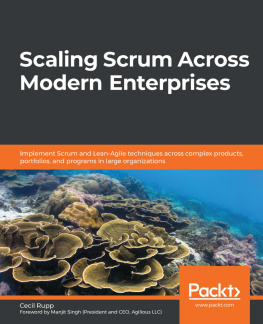About This E-Book
EPUB is an open, industry-standard format for e-books. However, support for EPUB and its many features varies across reading devices and applications. Use your device or app settings to customize the presentation to your liking. Settings that you can customize often include font, font size, single or double column, landscape or portrait mode, and figures that you can click or tap to enlarge. For additional information about the settings and features on your reading device or app, visit the device manufacturers Web site.
Many titles include programming code or configuration examples. To optimize the presentation of these elements, view the e-book in single-column, landscape mode and adjust the font size to the smallest setting. In addition to presenting code and configurations in the reflowable text format, we have included images of the code that mimic the presentation found in the print book; therefore, where the reflowable format may compromise the presentation of the code listing, you will see a Click here to view code image link. Click the link to view the print-fidelity code image. To return to the previous page viewed, click the Back button on your device or app.
Large-Scale Scrum
More with LeSS
Craig Larman
Bas Vodde

Boston Columbus Indianapolis New York San Francisco Amsterdam Cape Town
Dubai London Madrid Milan Munich Paris Montreal Toronto Delhi
So Paulo Sydney Hong Kong Seoul Singapore Taipei Tokyo
Many of the designations used by manufacturers and sellers to distinguish their products are claimed as trademarks. Where those designations appear in this book, and the publisher was aware of a trademark claim, the designations have been printed with initial capital letters or in all capitals.
The authors and publisher have taken care in the preparation of this book, but make no expressed or implied warranty of any kind and assume no responsibility for errors or omissions. No liability is assumed for incidental or consequential damages in connection with or arising out of the use of the information or programs contained herein.
For information about buying this title in bulk quantities, or for special sales opportunities (which may include electronic versions; custom cover designs; and content particular to your business, training goals, marketing focus, or branding interests), please contact our corporate sales department at or (800) 382-3419.
For government sales inquiries, please contact .
For questions about sales outside the U.S., please contact .
Visit us on the Web: informit.com/aw
Library of Congress Control Number: 2016941974
Copyright 2017 Pearson Education, Inc.
All rights reserved. Printed in the United States of America. This publication is protected by copyright, and permission must be obtained from the publisher prior to any prohibited reproduction, storage in a retrieval system, or transmission in any form or by any means, electronic, mechanical, photocopying, recording, or likewise. For information regarding permissions, request forms and the appropriate contacts within the Pearson Education Global Rights & Permissions Department, please visit www.pearsoned.com/permissions/.
ISBN-13: 978-0-321-98571-2
ISBN-10: 0-321-98571-0
Text printed in the United States on recycled paper at RR Donnelley in Crawfordsville, Indiana.
First printing, August 2016
Foreword
by Stephen Denning
Large-Scale Scrum or LeSS continues the major discoveries that are transforming the world of management by showing how to implement Agile and Scrum at scale.
In the 20th Century, hierarchical bureaucracy enabled large groups to work together to achieve extraordinary improvements in productivity. Then the world changed. Deregulation, globalization, the emergence of knowledge work and new technology, particularly the Internet, transformed everything. Competition increased. The pace of change accelerated. Computer software enabled huge gains in productivity but in turn generated immense complexity. As power in the marketplace shifted from seller to buyer, the customer, not the firm, became the center of the commercial universe. These shifts required fundamentally different management that could mobilize the talents of everyone in the organizationand beyondto meet the new and more difficult challenge of delighting customers. The changes went far beyond fixes to existing management practices. Agile and Scrum offer explicit alternatives to seemingly long-held, obvious, self-evident management assumptions.
LeSS shows how to handle large and complex development. Self-managed teams are not just tiny curiosities. They can manage vast international operations of great technical complexity. The practices are not only scalable, unlike bureaucracy, they are scalable without sclerosis.
LeSS continues the process of fundamentally reinventing management by incorporating the hard-won lessons of experience over more than a decade in scaling the management methods of Agile and Scrum. It shows how to cope with immense complexity by creating simplicity.
LeSS is deliberately incomplete. It leaves space for vast situational learning. It doesnt offer definitive answers. Nor does it try to satisfy 20th Century longings for formulaic answers or for apparently safe and disciplined approaches that offer a comforting illusion of predictable control. LeSS focuses on the minimal essence required when scaling, including continuous attention to technical excellence, and a mindset of continuous experimentation. It involves forever trying new experiments in an effort to improve. Like Scrum itself, LeSS strives for a balance between abstract principles and concrete practices.
And like Scrum, LeSS is not a process or a technique for building products. Rather, it is a framework within which processes and techniques can be adapted to meet the needs of the particular situation. It aims to make clear how product management and development practices can enable continuous improvement that adds value to customers.
Rather than providing fixed answers, LeSS provides the starting point for understanding and adopting its deeper principles. Instead of asking, How can we do Agile at scale in our complex hierarchical bureaucracy? it asks a different and deeper question is, How can we simplify the organization, and be Agile?
LeSS strives to achieve this balance for larger product groups. It adds more concrete structure to Scrum, while maintaining radical transparency and emphasizing the inspect-and-adapt cycle so that groups can continuously improve their own ways of working. It addresses the basic question: How do we take what works really well at the individual team level and make that happen at a much wider level in the organization?
Much remains to be learned and done in terms of scaling Agile and Scrum. This book is both a progress report and a guide to the future. At present, many organizations are not doing a good job having multiple teams working in sync on various aspects of products and platforms. Surveys show that most Agile and Scrum teams today report tension between the way their team operates and the way the rest of the organization is run. This book provides a practical, step-by-step guide to resolving this tension.
Stephen Denning
Author of The Leaders Guide to Radical Management
April 27, 2016
Preface
All great truths begin as blasphemies.
George Bernard Shaw
Welcome to this portal into the world of LeSS, where simpler structures replace organizational complexity by focusing on people and their learning. To some people, LeSS might seem romantic and hopelessly idealistic. Not so, it is the








